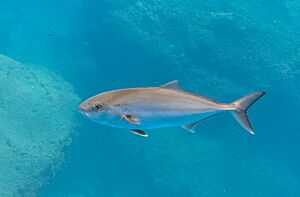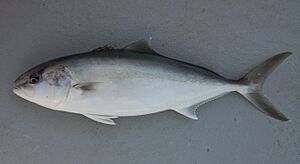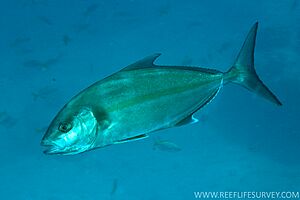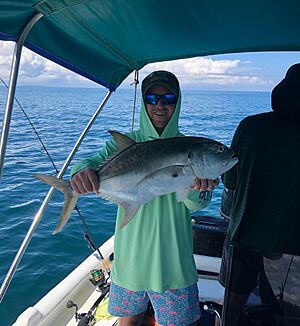Greater amberjack facts for kids
Quick facts for kids Greater amberjack |
|
|---|---|
 |
|
| Conservation status | |
| Scientific classification | |
| Synonyms | |
|
The greater amberjack (Seriola dumerili) is a large, fast-swimming fish found in warm oceans all over the world. It is also known by many other names, like reef donkey or yellowtail. This fish belongs to the family called Carangidae, which includes jacks and pompanos.
Greater amberjacks are popular for fishing and are also caught for food. They are the biggest fish in their family.
Contents
What Does a Greater Amberjack Look Like?
The greater amberjack is a big fish with a long, sleek body. Its color can change from brownish to bluish-grey on its back, with a shiny silver-white belly.
It has a dark stripe that goes from its nose, across its eye, and towards its first back fin. Sometimes, you might see a light yellow or reddish-brown stripe along its sides. Its fins are usually dark.
Younger amberjacks have clear fins and five dark stripes on their bodies. The largest greater amberjacks can grow up to 190 cm (75 in) long and weigh over 80 kg (180 lb)!
Where Do Greater Amberjacks Live?
Greater amberjacks live in warm, tropical, and subtropical waters around the globe. You can find them in the Indian Ocean, along the coast of Africa, and all the way to Western Australia and Japan. They also live near the Hawaiian Islands.
In the western Atlantic Ocean, they are found from Nova Scotia down to Brazil, including the Gulf of Mexico and the Caribbean Sea. In the eastern Atlantic, they are seen from the Bay of Biscay to Morocco and in the Mediterranean Sea.
Habitat and Life Habits
Where They Live
Greater amberjacks can be found alone or in small groups. They often hang out near coral reefs, deep underwater caves, rocky areas, and shipwrecks.
Younger fish sometimes hide among floating plants like Sargassum or other floating objects far out at sea. Smaller amberjacks (under 3 kg (6.6 lb)) can be found in shallow waters. Larger fish prefer deeper areas, usually between 18 m (59 ft) and 72 m (236 ft), but they have been seen as deep as 360 m (1,180 ft).
What They Eat
Adult greater amberjacks are active hunters. They eat other fish, squid, and crabs. Some of their favorite meals include bigeye scad and sardines.
Younger amberjacks start by eating tiny sea creatures called plankton. As they grow, they begin to eat larger prey. Once they are about 20 cm (7.9 in) long, they mainly eat other fish and move closer to coastal areas.
Reproduction and Life Cycle
Male and female greater amberjacks are separate from birth. They start to look different around 4 to 5 months old. In the Mediterranean Sea, males become ready to breed at 4 years old, and females at 5 years old.
A single female can lay a huge number of eggs, sometimes between 18 million and 59 million in one breeding season! Off the coast of Florida, they usually lay eggs in April and May.
The eggs are very small, about 1.9 mm (0.075 in) wide. After about 40 hours, tiny larvae hatch. It takes about a month for these larvae to grow into young fish. Greater amberjacks can live for up to 17 years.
Who Eats Them?
Larger fish, like yellowfin tuna and European hake, sometimes hunt greater amberjacks. Seabirds, such as the brown noddy and sooty tern, also prey on them.
Sometimes, greater amberjacks can have harmless tapeworms or other tiny parasites on their gills. These are not harmful to humans.
How Humans Use Greater Amberjacks
The greater amberjack is an important fish for food. It's also a very popular fish for sports fishing, earning its nickname "reef donkey" because it puts up a strong fight!
In Japan, its meat is used for sushi and sashimi. In places like Florida and Mexico, it is sold fresh and can be fried, baked, or grilled.
People often catch them by using fishing lines with artificial lures or natural bait. Sometimes, anglers catch them by accident while trying to catch other fish like snappers or groupers.
Naming the Greater Amberjack
The greater amberjack was first described by a French scientist named Antoine Risso in 1810. He gave it the scientific name Caranx dumerili.
The second part of its name, dumerili, honors a French zoologist named André Marie Constant Duméril. The name Seriola is the Italian name for this type of fish.





